105th Evacuation Hospital Unit History
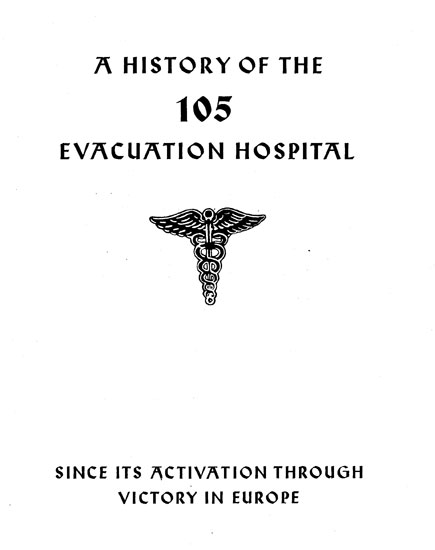
Title page of the History of the 105th Evacuation Hospital, describing its activities in the European Theater of Operations during World War 2.
Activation & Training:
In fact the 105th Evacuation Hospital, Semimobile, was already constituted 25 February 1943 in the Army of the United States at Cp. Cooke, Oceano, California. A first Officer, Captain Robert O. Martin reported at the station on 10 March 1943, he was followed by a second Officer, 1st Lieutenant James L. Andresen (who was to head the Registrar’s Section) on 22 March. Lt. Colonel Ronald C. Anderson who reported on 23 March at Cp. Cooke, assumed command of the Hospital.
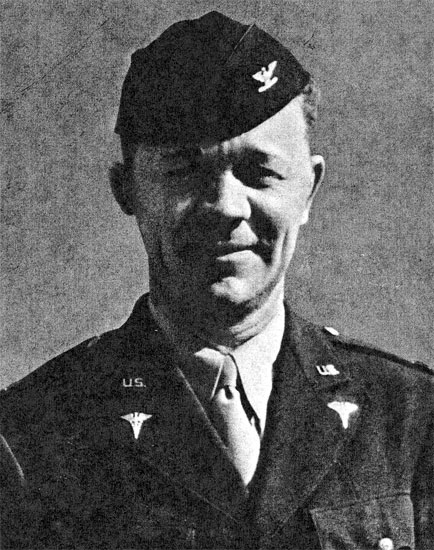
Picture of Colonel Allan C. CRAIG, MC (CO > 105th Evacuation Hospital, May 44 > Aug 45).
Construction of Cp. Cooke began in 1941, and although far from complete the installation was already activated on 5 October 1941. Training couldn’t wait and in February-March 1942, the 5th Armored Division rolled into camp. Other units were stationed at the camp for training, including the 6th Armored – 11th Armored – 13th Armored and 20th Armored Divisions; the 86th Infantry and 97th Infantry Divisions, and the 2d Filipino Regiment. In 1944, Cp. Cooke covered an area of 88,803 acres and it had a troop capacity of 2,346 Officers and 35,288 Enlisted Men. Later in the war, German and Italian PWs were quartered at Cp. Cooke.
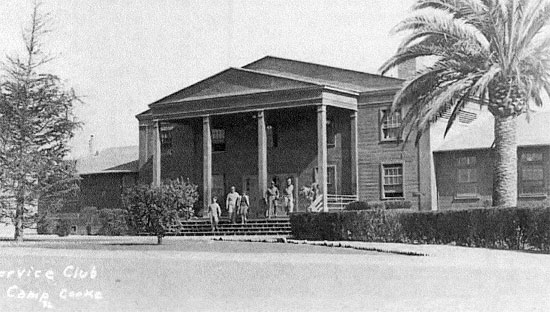
1943 picture illustrating the Service Club, Cp. Cooke, Oceano, California.
The 105th Evacuation Hospital was activated on 1 April 1943, by G.O. 28, II Armored Corps, at San José, California under the command of Lt. Colonel Ronald C. ANDERSON, as part of the II Armored Corps. In fact, Lt. Col. R.C. Anderson already reported on 30 March in order to assume command of the unit. The same day, the cadre of 1 Officer and 34 EM arrived from Cp. Breckinbridge, Morganfield, Kentucky (Infantry Division Camp). They were immediately given a refresher course, with particular emphasis on drill, discipline, military courtesy, and physical training. Filler replacements began to arrive on 3 May, additional recruits joined the unit on 29 May 1943, and the last 99 draftees from the Ft. Hayes Reception Center (Ohio) brought the unit to its authorized strength.
An ambitious Training program was set up with bivouacs, night marches, classes, calisthenics, drill, and inspections, which numbed the minds and bodies of all. Some people went off to Army Specialist Schools, while others went to the Station Hospital for additional medical training.
Unit training then began in earnest, new Officers and Enlisted Men were assigned to the 105th and Colonel Dale G. FRIEND, a veteran of the Pacific campaigns, moved in as the new CO. Simulated casualties poured into the Hospital as it accompanied the 6th Armored Division on Maneuvers in the hills near Santa Maria.
On 23 December, orders were received to move to the California-Arizona Desert Maneuver Area, and on 5 January 1944 the Hospital arrived at Yuma, Arizona, taking over the area formerly occupied by the 98th Evacuation Hospital.Meanwhile Officers, Nurses, and additional Enlisted personnel were plunged into a final training stage (run by Second US Army), and Lt. Colonel Allan A. CRAIG, MC joined the unit as the new Commanding Officer (15 May 44), he was promoted to full Colonel a few weeks later, and after final inspections, two dances, and a beer party, the Hospital unit departed by rail on 12 March for its new home: Ft. Jackson, Columbia, South Carolina (Infantry Training Center), where it arrived on 16 March 1944. Major Wilmer J. LANG, MAC, was appointed XO, and Captain Horace R. BENNETT became the Chaplain.
Ft. Jackson, was the place where the final training phase before leaving for overseas assignment started. The heat was the most annoying factor encountered. The numerous parades, the mass calisthenics, the obstacle course, the hikes, the classrooms, the physical fitness tests, never seemed to stop. At times the 105th teamed up with the 1st Convalescent, the 130th Evacuation, and the 131st Evacuation Hospitals to practice for reviews and inspections. Luckily, social life wasn’t too bad; there was the PX, the theaters, the service clubs, the library, and the passes and furloughs to enjoy.
The various training phases included establishing a Hospital in the field. Erection of an Evacuation Hospital required between 4 to 6 hours. After selecting the required location, the CO decided upon the type of shelter to be utilized, the extent of the initial establishment, and the priority of the different departments to be set up. There was a standard order of priority for the erection of tentage facilities (based on early establishment and priority of vital units). The following guide was therefore used for setup of the different tents and facilities:
- Receiving wards
- Sorting and pre-operative wards
- Shock wards
- Operating rooms and sterilizing facilities
- X-Ray section
- Dressing and Dental sections
- Pharmacy and Laboratory
- Headquarters and Registrar’s section
- Messes, including kitchens
- Wards, Medical and Surgical
- Latrines and screens in designated areas
- Quarters for personnel
- Remaining administrative offices, Supplies & Utilities, and storage facilities
- Other installations
After distributing the necessary tentage and section equipment throughout the selected area, all available men were organized in squads consisting of 1 NCO and 8 EM for the erection of a particular tent. Disestablishing an Evacuation Hospital required about 8 to 10 hours. When the Hospital moved again, it stopped receiving casualties. While the majority of personnel packed up and moved to another location, another part remained behind to care for the patients until they had all been evacuated.
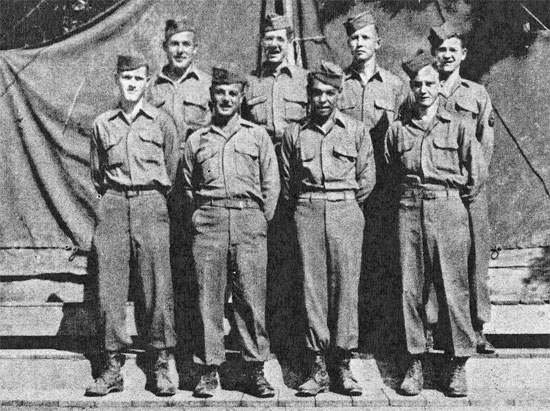
Picture showing personnel of the Receiving & Evacuation Section. It consisted of 2 Officers and 9 Enlisted Men whose tasks included triage of patients, assignment to wards, initiation of field medical records, checking and safeguarding patients’ valuables, evacuation of patients to rear echelon facilities, and arranging transportation for duty patients discharged from the Hospital.
On 10 August 1944, the 105th Evacuation Hospital left Ft. Jackson via rail for its Staging Area – Cp. Kilmer, Stelton, New Jersey. This was the place where the last shots were received, where gas casualty classes were held, and where final inspections took place! As it wasn’t very far from New York or Newark, the majority of the men ate into their next six months pay.
After arrival the next day, troops prepared for deployment overseas, and after passes, the men were finally alerted on 25 August, and departed Cp. Kilmer on 27 August 1944 at 1815 for NY P/E, Brooklyn, where they boarded the “Queen Elizabeth” at 2200, to the strains of the “Beer Barrel Polka”.
Arrival in the ETO:
The 105th Evacuation Hospital had a safe trip across the Atlantic without much undue excitement and reached the Scottish shores, anchoring at Glasgow on 3 September, where personnel was taken ashore in lighters and subsequently entrained in a chill, drizzling rain. Bournemouth was reached two days later. The unit spent almost a complete month at this former resort city, getting to know the English through their daily contacts. Everyone seemed to feel at home, and many men had local girl friends. On 22 September the 105th entrained and headed for Southampton and Staging Area C-5. The news finally came: the 105th Evacuation Hospital was to proceed to the Port of Southampton, and to embark there for transportation across the Channel to France! Officers and Enlisted Men were to travel on the English steamer SS “Duke of Wellington”, while the Nurses were to cross on a Dutch boat, SS “Mechlinburg”.
After a safe crossing everyone transferred to LSTs and LCTs and stepped on to the grounds of Omaha Beach. The day was 5 October 1944. The Officers went by motor convoy to the Valognes Staging Area that night, while the EM followed the next day. The Nurses went to Ste-Mère-Eglise.

Group of Nurses working with the 105th Evacuation Hospital.
After landing, the Supplies and Utilities Section went to work. It was time to catch the war and become ready to function! In spite of some dedicated men guarding the Hospital’s supplies in a sea of mud, some people were still ‘borrowing” things. When the 105th went into operation, the department really began to function and even provided services not listed in the provisions of the T/O. Enough black-out shades were built to outfit every building in Holland and Germany. Oxygen remained always available, day and night. Moving supplies with a limited Motor Pool proved difficult at times, but arranging side trips to Medical Depots, and scrounging for more transportation, solved many problems. Eventually, the Motor Pool became known as the “105th Quartermaster Trucking Company”. The value of bicycles, motorcycles, and loot of all description was learned fast in the ETO.
The new area, designated D-24-25, furnished reminders of the war that has so recently passed through – helmets, hand grenades, battered tanks and half-tracks, scattered ammo, all gave mute evidence. On 11 October, the whole group left for Carentan, and after arrival, entrained in 40 & 8 boxcars, ready for a journey across France. The trip went from Carentan to Versailles, Paris, Verdun, further on to Maastricht (Holland, arrival 160500 Oct 44), where the unit detrained and proceeded by motor convoy to Tongres (Belgium). Officers were quartered in Ward tents, Nurses in a nearby Château, and EM slept in pup tents. Mess facilities were arranged for at the 606th Medical Clearing Company. While in Belgium, contacts were made with the 100th Evac and 20th Fld Hosp. The 105th would remain at Tongres until 28 October. The cold, rain, and mud wore everybody’s patience thin and it was without the least reluctance that the hospital unit pulled up stakes and moved on to Maastricht, Holland.
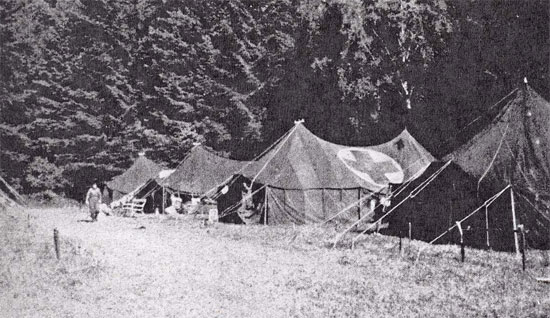
Partial view illustrating Nurses’ Quarters in the field (location and date unknown).
Organization (functions):
Administrative Sections
Detachment Headquarters – administration, discipline, duty assignments, training, security, guard
Supply and Utilities Section – procurement, storage, issue of supplies, salvage collection and disposal, laundry exchange, disposition of patients’ clothing and equipment, installation, repair and maintenance of all utilities
Mess Section – patients’ mess, enlisted men’s mess, officers’ and nurses’ mess, preparation, storage of food
Transportation and Maintenance Section – operation, care, and maintenance of motor transport, and other vehicles
Registrar’s Section – records of sick and wounded, reports, statistics, patients’ clothing, patients’ valuables
Receiving and Evacuation Section – reception, triage, records, patients’ clothing, patients’ valuables, hospital clothing, property exchange, disinfestation, dispensary
Professional Sections
Operating Section –surgical service, ward duty assignments, sorting surgical cases
Ward Section – internal medicine, neuropsychiatry, ward duty assignments, organization of medical sections, medical records
Pharmacy and Laboratory Section – preparation and issue of drugs, prescriptions, keeping of medical and narcotic records, tests, urinalyses, blood counts, blood typing, serology, autopsy, morgue
X-Ray Section – supervision, X-ray pictures, fluoroscopy, records
Dental Section – dental procedures, dental laboratory work, records
Red Cross Detachment – patients’ welfare, recreation activities
First Operations in the ETO:
The 105th Evac Hosp opened as a Convalescent Hospital for a few weeks (29 Oct > 16 Nov 44) in Maastricht, and then reverted to active Evacuation Hospital status! The first patients were received from troops fighting near Aachen, and this was to be the first real encounter with the grim products of the battlefield. For the first time, personnel came to know what victory and defeat meant in the cost of human life and suffering. Downtown shops were empty but the local people were friendly and welcomed the soldiers into their hearts and homes. After a while, almost everyone had a Dutch home to which they could go and enjoy a few of the pleasures they remembered from civilian life. Adjusting to the incessant drone of buzz-bombs overhead and the routine of combat was certainly more difficult.
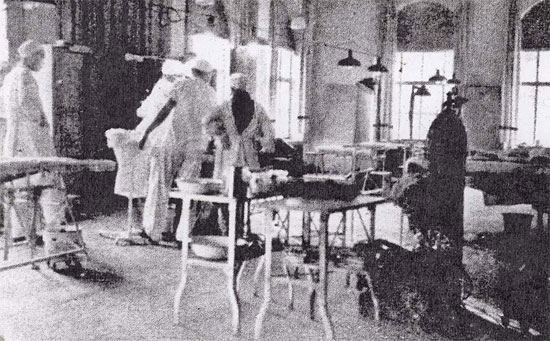
Surgery in action. Picture taken in Maastricht, Holland, where the Hospital set up in a building (October 1944 – February 1945).
Cooperation, collective thought, flexibility, and above all, plain hard work, were the contributions to reach high standards within the unit. Fortunately, most of the Hospital’s locations were in buildings and as a result, a 5-Ward breakdown was used in preference to the prescribed 20-Ward arrangement.
Ward 1 (pre-operational) where personnel gave the patients their first care and treatment.
Ward 2 (transportable surgical) which held the patients for a short time; duties included post-operative treatment, observation, medication, and follow-up of reactions after surgery.
Ward 3 (non-transportable surgical) which treated patients with serious injuries who were to stay in Hospital indefinitely.
Ward 4 (contagion) which kept primarily busy with prevention of transmission of disease, a place where caps, gowns, and masks were familiar objects.
Ward 5 (medical) which handled NP cases, and general pill rolling and treatments.
Then the German Counteroffensive came, and the attack in the Bulge sector caused a feeling of panic while everyone was making preparations to either evacuate or retreat, whichever was needed … The Hospital was transferred to First Army and now began to receive numerous casualties from units that had been shifted to meet the Germans sweeping northward. The threat of encirclement was real, the German breakthrough was on, and those were to become wild days and nights as Christmas rolled around. The Hospital closed down its operations on Christmas Day, 25 December 1944.
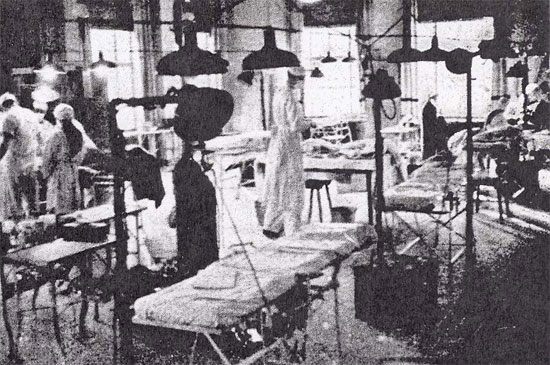
View illustrating one of the Operating Rooms in action. Picture taken during the Hospital’s stay in Maastricht, Holland.
Luckily a welcome rest period followed and New Year Eve came along. Officers and Nurses were celebrating with one of their parties in the second story wing of the building, when early in the evening the AA battery a block away started firing but few paid much attention. German planes droned overhead and occasionally strafed and bombed. No one thought of going to the air raid shelter. Then the noise outside doubled as other anti-aircraft guns joined in – an enemy bomber came in low, and then an electrifying scream terminated in a terrific explosion that shook the building! Glass flew everywhere, and a mass stampede followed in the direction of the air raid shelter in the basement. As the noise outside grew less, the buzz of excitement inside diminished and left only sober minds and faces gaunt with tired lines – order was gradually restored and each sough a place to spend a restless night. The next morning, a big job awaited everyone, debris was cleared away and damage estimated. Bombs had landed only about 50 feet from the building and blown tentage and equipment over great distances. A bomb disposal crew unearthed a 500 lb German bomb and deactivated it. All windows had been shattered, glass lay everywhere including pieces of furniture, wash basins, cupboards, and small material, the beds were luckily unoccupied at the time of explosion, but the Luftwaffe New Year’s greeting could have meant the end of the 105th.
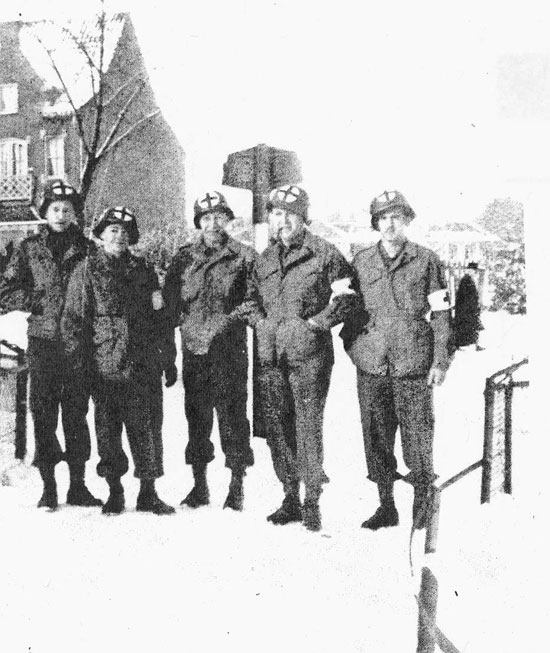
Group of medical personnel in the snow. Picture taken in Maastricht, Holland, during winter 1944-45.
The Hospital re-opened on 1 January 1945. Allied troops had now been massed in the Ninth United States Army sector as soon as the situation had eased in the Belgian Ardennes. Sittard, Holland, was the next destination, where the 105th arrived at 091600 Feb 45. The Hospital moved into the buildings of the local Parochial School and waited for things to begin, while the majority of personnel were billeted in local homes. Off-duty time was spent getting to know the people in whose homes the men were billeted. Some lasting friendships were made during those chill, rainy days, as groups would gather with members of the household in the living room around a fire of precious hoarded coal and wood. Here again the medical personnel were met by kind people, whose gratitude was immense, having been recently liberated. Meager comforts, some food and cigarettes were shared, while reminiscing about the respective ways of life… After the crossing of the Roer River had begun, friendly casualties began to filter back, the Germans had planted lots of mines, and the grisly amputations began.
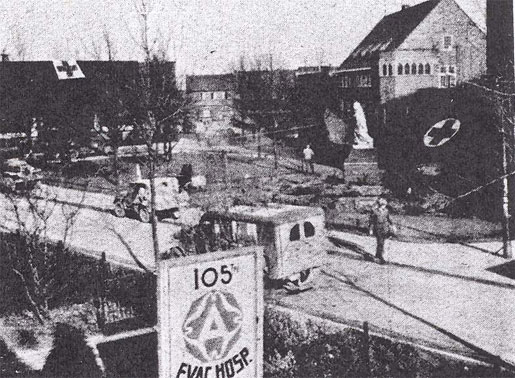
Partial view of Sittard, Holland. The Hospital set up in some buildings belonging to the local Parochial School with most personnel billeted in private homes. The 105th remained in Sittard from 9 February 1945 to 8 March 1945.
Into Germany:
After the boys had crossed the Roer and swept to the Rhine, everyone prepared to move onto enemy soil. This was to be a new experience, and after living most of the time among a friendly civilian population, the 105th was now to be confronted with the enemy himself.
On 8 March 1945, the 105th Evacuation Hospital closed and moved to Mülhausen, Germany. This was to be the first setup in enemy country. The unit was housed in a building that had formerly held Gestapo agents, and before them, it had been a Girls’ School run by Nuns. Until now, everyone had lived in recently liberated countries with a friendly civilian population. The Allies swept to the Rhine River, and as the troops rumbled past racing further into Germany, the Hospital was ordered to move again and set up in the vicinity of a town called Wulfen. On Eastern Sunday the unit moved forward and crossed the swollen Rhine. 30 to 40 Ward Tents had to be set up in rain, on soggy ground, while ambulances loaded with seriously wounded Americans were already waiting… those hectic days at Wulfen earned it the nickname of “Hell Hole”. As the troops moved very fast, medical units often found themselves in the rear echelons of the spearhead. The Army kept up the space, and the Hospital unit was now ordered to move on to Bad Oeynhausen, just leaving behind a Clearing Company to take care of the remaining patients. Because of the swift advance by the armored divisions, the new location was never used, and on 11 April the unit was ordered to continue to Hannover (later nicknamed ‘Hangover’) which it reached the same day. The Hospital took over a few civilian cars for its use and because of an ambulance shortage even used limousines to evacuate wounded to the airstrips. Casualties poured in from both the advance troops and the mopping-up elements, until things started to slow down, after the Elbe had been reached! Inevitably, the patient load increased again due to the exigencies of war, thus additional help was obtained and a Litter Bearer Platoon from the 508th Medical Collecting Company was attached. Its Commander, Lt. Schnieder took over responsibility of the Hospital’s Evacuation Section and rendered inestimable assistance to the unit.
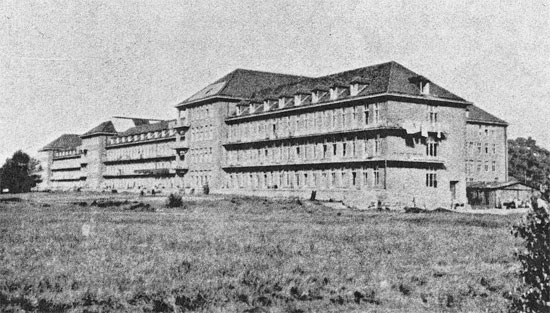
Overall view of the building that housed the 105th Evacuation Hospital in Hannover, Germany. Picture taken in April 1945.
The many headaches which plagued the administration of the Hospital were aggravated by the strange assortment of patients admitted. Not only American patients, but also other Allies, and civilians of the liberated countries were often encountered and admitted for treatment. Around and after V-E Day, with Germany on the verge of collapse, a melting pot of French, British, Russian, Italian, Polish, Hungarian, Dutch and German soldiers found their way to the Hospital. It was hard work requiring long hours of tedious typing, writing and compilation of figures and records, to submit the necessary data to the Medical Department and the Surgeon General’s Office.
During the period of relative inactivity just before V-E Day and immediately thereafter, members of the command had a wonderful opportunity to go on reconnaissance missions over virgin souvenir territory. The usual aggregation of cameras, pistols, field glasses were scrounged, clerks were deluged by torrents of state-bound mail. The non-fraternization policy was to be followed, but then, the beautiful mademoiselles from the DP camps found that theirs was an international language. Then V-E Day and its accompanying celebrations, eased up the situation, now the big question was: “where do we go from here?” – The Army let sit everyone more than a month before it said, “off to Bad Nauheim and Seventh Army!”. Radio reports said Ninth Army was on its way home.
The new bivouac spot at Bad Nauheim (reached at 111730 Jun 45) was ideally situated to the taste of most, and it was a pleasure to sit outside the tents, basking in the sun, and reminiscing about civilian life. During this rest period, there was time to enjoy the beautiful scenery, take a hike, engage in sports, or see a picture. Every now and then a flurry of rumors would float around the area and the Hospital began to lose personnel, Officers going first, and then came the horrible news, the 105th Evac Hosp was now designated a “category IV” unit and scheduled for deactivation! What a blow to morale! The final blow came when transfer of 30 men to the 19th Replacement Depot was announced, then the CO, Colonel A. A. Craig was to go (he was transferred to the 133d Evac Hosp), being replaced by Lt. Colonel Eugene W. Demaree. Almost everyone predicted a 10-year stretch in the Pacific with some alien outfit.
On 5 August the unit moved to Bad Mergentheim, and then came V-J Day and hopes soared once more – when there was talk to turn over the Hospital to the 59th Evacuation Hospital and move to Ellwangen, this was 2 September 1945 – everyone hoped the next move was to be home … it was!
As a matter of fact after V-E and V-J Days had come and gone, the Hospital staff had been doing almost nothing but wait for the boat to take them home. The unit had been pretty well broken up, and lost many Officers and Enlisted personnel, with whom they had been for almost two years, a sad moment.
Poem: Normandy to Belgium
Forty and eight, forty and eight,
We ran for the streamliner and caught the freight.
We rode like hoboes, and felt like bums,
As we traveled on in those portable slums.
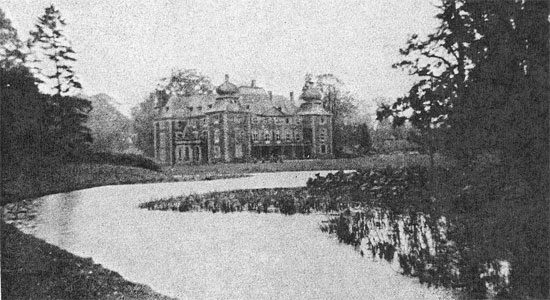
Picture of the Château where the Nurses were quartered during their limited stay at Tongres, Belgium (16 Oct 44 > 28 Oct 44). The Officers slept in in large ward tents, and the Enlisted personnel had to do with pup tents.
Unit Roster:
| Officers: | ||
| ANDERSON, Ronald C. | GAGER, Walter O. | MASSEY, Walter |
| ANDRESEN, James L. | GARRETT, Robert | MORROW, Paul N. |
| BEATTIE, John F. | GEORGACAKIS, George S. | MURRAY, William J. |
| BRONISTKY, Jacob | GONZALEZ, Rodriguez J. | PERRY, Samuel O. |
| BUNKFELDT, Frederick Jr. | GREENBERG, Benjamin | PITTMAN, James E. |
| BUTLER, Raymond K. | GREENE, Joseph M. | PODESTA, Joseph J. |
| COLTON, Edgar L. | HARPER, Melvin A. | SAVAGE, Arthur R. |
| CONGER, Preston D. | HERTZ, Simon | SCHOENHOLZ, Seymore M. |
| CRAIG, Allen A. | HUMPHREY, Issac | SEALE, James N. |
| DAMRON, Carl R. | KALIL, Charles | SELKIN, William |
| DAVIS, Albert, I. | KAMMERLING, Donald | SLAMA, John T. |
| DEEB, Charles H. | KELLEY, James W. | SMAZAL, Stanley F. |
| DEMAREE, Eugene W. | KINCOV, Jacob | STARK, Richard B. |
| DICHTER, Irving S. | KUPFERBERG, Alfred B. | STEINBERG, Milton |
| ELICKER, Charles R. | LANG, Wilmer J. | STERN, Edward A. |
| ELSBACH, Kurt J. | LOEHNER, Conrad | SWIETER, Kenneth L. |
| EMMONS, James E. | LOSEY, Dewayne A. | VAN KIRK, Frank W. |
| FAZIO, Rocco J. | MacINTYRE, Dugald S. | WAGNER, Robert M. |
| FLAX, Ellis | MARTINDALE, Charles A. | YEMM, Warren A. |
| Nurses: | ||
| ABRAHAM, Norma F. | EVESLAGE, Dorothy E. | PEDERSEN, Gertrude M. |
| ACCORDINI, Feliciana M. | FELIX, Eudora C. | RAY, Doris R. |
| ADAMS, Lorraine C. | GARSON, Martha A. | REECE, Ruby D. |
| ALLEN, Marie W. | GIST, Martha H. | RENNEY, Kathryn L. |
| BALLARD, Josephine C. | GOLISH, Anna M. | ROBERTS, Irene M. |
| BASH, Oghna | GOLL, Carol A. | SCHONES, Katherine |
| BRADY, Mary L. | GOMBAR, Margaret | SEXTON, CECELIA N. |
| BURWELL, Kathleen | GREENAN, Patricia | SMITH, Edith C. |
| DANNER, Mae I. | HALL, Ursula | SNELL, Christine A. |
| DAVIS, Betty J. | HILTON, Marie C. | STANDLEY, Lucile |
| DESMOND, Johanna | HOLER, Kathryn N. | STIRLING, Thelma M. |
| DOAK, Wilmadine | KIMBLE, Regina | VOGT, ANNA L. |
| DOWER, Janetr K. | LLOYD, Jane | YORKE, Mary |
| ENGLE, Rachel | MILLER, Dorothy | WALDOCK, Eleanore M. |
| ESPEL, Doris R. | PAUL, Phoebe M. | WITHERS, Mary Jane |
| American Red Cross Workers: | ||
| OGLEVEE, Edna | POWERS, Dorothea | SHORTLEDGE, Anne |
| Enlisted Men: | ||
| ALAMILLO, Ralph | GENSOUL, Adrian R. | PERKINS, Jack C. |
| ALT, Kermit | GILLETTE, John R. | PERKINS, Robert J. |
| ANDRUES, Grady H. | GLOVER, Max | PESHEL, Joseph |
| ARNETT, James W. | GOZDOWIAK, Edward F. | PICCIANO, Donald |
| AYERS, Charlie R. | GRAY, George B. | PIEKELNIAK, Stanley M. |
| BACHETTI, Bruno J. | GRAY, Joe H. | PINKERTON, Albert R. Jr. |
| BAILEY, Robert J. | GREGSON, Frederick A. | RAATZ, John |
| BALASSI, Renzo E. | GRIBBLE, Orval C. | RAMPONI, Kenneth |
| BANDONI, Leo | GUTERREZ, José J. Jr. | REGAN, William |
| BATES, Lawrence | GUSTAFSON, Victor | REVIA, Clarence |
| BENEDETTO, Godfrey C. Jr. | HAGEMAN, Paul E. | ROBARGE, Daniel |
| BERRY, Robert | HARRIS, Charles E. | ROGERS, James H. |
| BEVERAGE, Joseph | HAWVERMALE, Chester E. | ROGERS, Homer J. |
| BINDAS, Joseph | HEMPY, James F. | RUBENSTEIN, Charles |
| BOLITHO, Joseph F. | HERNANDEZ, Julian | RUSSELL, Lowell, J. |
| BOLYARD, Leo | HIBBS, Charles C. | ROTRUCK, Allen M. |
| BRADFORD, Carlos L. | HIGHMAN, Everett R. | SAVARESE, Ted |
| BRADSHAW, Charles H. | HILL, Clyde E. | SCOBEE, Albert R. |
| BRICENO, Joseph | HILL, James | SCHIPSI, Arthur |
| BRIGGS, Raymond G. | HOLTZ, Edwin J. Jr. | SCHOBER, Gerald |
| BRUICH, Samuel | HOSTETTER, James | SCOTT, Art |
| BUNCH, Edward | HUGHES, Howard B. | SEAL, Max E. |
| BURNS, Carl E. | HUGHES, Lawrence M. | SEVER, Louis T. |
| BUTLER, Harvey | HUMPHREY, Herold O. | SHAFFSTALL, Lloyd H. |
| CADY, Jack A. | HUSTON, Lewis | SHANHOLTZ, Paul |
| CARLSON, John L. | INICIS, Victor P. | SHANNON, Alvin M. |
| CARLSON, Leonard F. | IRWIN, William F. | SHAW, James R. |
| CARMEANS, Estelle | JONES, Charles | SHERWOOD, Everson |
| CARR, Theodore A. | JONES, Robert P. | SHUSTER, David H. |
| CATALANO, Joseph | JOHNSTON, Hugh L | SIMMERS, Franklin |
| CARPENTER, Edward F. | KEENAN, George | SKAMER, Donald J. |
| CARPENTIER, Armand J. | KEISER, Ralph D. | SKIDMORE, Billie |
| CARPENTIER, Helaire | KELLY, Hugh | SMITH, Ernest L. |
| CAPPETTI, W. J. | KING, Carl C. | SMITH, George A. |
| CHRISTOFILAKES, Leonidas | KINNE, Joseph V. | SMITH, George J. |
| CLEMENT, Joseph J. | KIRCHNER, Richard F. | SMITH, James |
| CONKLE, Howard | KOPRINCE, Daniel | SMITH, Otis L. |
| CONROY, Richard L. | KORBA, Andrew | SMITH, Walter L. |
| CRANE, James A. | KOUFOS, John C. | SOLOFF, Roy L. |
| CROUCH, Guy F. | KURNICK, Edward P. | SPENCER, Emmett W. |
| DAMORE, Guy F. | LAM, Vincent F. | STERLING, Claude J. |
| DAVENPORT, Edward C. | LARGENT, Lenwood | STEWART, Thomas L. |
| DAVIDS, Harvey | LARSON, Edward L. | STOKICH, Lewis |
| DAVIS, Robert A. | LAZARAKIS, Samuel J. | SUPP, Eugene F. |
| DEAN, Herold V. | LESCENSKI, Joseph W. | SUTTON, Hubert R. |
| DE LAWDER, Paige | LEVINE, Irving | TARLTON, Allen |
| DELLAMANDOLA, Pete | LINDIMORE, Leslie R. | TAYLOR, Talmadge M. |
| DENTON, Coy E. | LINDSAY, Herman B. | TERRY, Milton |
| DERREVERE, Dale E. | LINEWEAVER, Paul K. | THOMPSON, George S. |
| DE TOMASI, Aldo | LINN, GEORGE F. | THORP, Edward C. |
| DOUCETTE, Leon A. | LOMBARDI, Lawrence | TOWNSEND, Henry B. |
| DULL, Roger L. | LORENZ, Jay L. | TURNBULL, Alex |
| DUNCAN, Andrew J. | LUCCI, John | TURNER, Ed D. |
| DUNLAP, Chant A. | MACHAMER, Donald R. | TYLER, Julian L. |
| DURDEN, William | MANNING, Harold C. | VISEL, Charles H. |
| DRIVER, Eneth S. | MARQUEZ, Russell C. | WAGNER, Ralph G. |
| DUPUIS, John L. | MASINGILL, Cleo G. | WAGONER, John H. |
| EBELBERGER, Ferdinand J. | MAY, Frederick T. | WARREN, Paul |
| EDDINS, Harold V. | MAZMANIAN, Haig | WARREN, Ralph |
| ELLET, Charles | McALLISTER, Walter R. | WEBER, Robert |
| ENLOW, Lloyd C. | McCARTHY, John | WELLMAN, Walter R. |
| ENGE, Ralph E. | McDANIEL, Harley B. | WELLS, Charles E. |
| ESPINOSA, Hugo M. | McLAREN, John | WHITEMAN, Roy |
| EVANS, Charles | McMURDO, George W. | WICKMAN, George G. |
| EVANS, Jack | MENACHO, Frank | WILCOX, Robert |
| EVANS, Kenneth W. | MESSERSCHMIDT, Eugene H. | WILFONG, Norman C. Jr. |
| FARLEY, Goscoe O. | MONK, William H. | WILLIAMS, George |
| FARR, William M. | MORENO, Earl C. | WILLIAMS, Wilfred A. |
| FAWCETT, Lawrence | MONTGOMERY, Clifford H. | WILSON, Carl L. |
| FILES, Ralph C. | MYNK, Larry J. | WILSON, Robert |
| FLEMING, David B. | NOLAN, Terrence J. | WISCONS, Michael C. |
| FLETCHER, Leno E. | NORCROSS, Joe E. | WITTEK, Emil |
| FLINT, Jim H. | NYLUND, MILTON e; | WOOLEY, Alton |
| FRANK, Charles E. | O’HARA, Jack | WRIGHT, Harold B. |
| FRAVEL, James A. | OLIVER, Leonard | YERIAN, Robert |
| FRISK, Roy C. | PAIRAN, John | YOST, Marvin R. |
| FUNK, Paul E. | PALMER, William A. | ZICKEFOOSE, Margel W; |
| GARDNER, George R. | PATRICK, Jesse T. | ZIROLI, Dominic |
| GAZULIS, Peter N. | PEEL, Alvin R. | ZYLKA, Bennie D. |
Troops served by the 105th Evacuation Hospital:
| Zone of Interior | Fourth Army | 95th Infantry Division |
| Second Army | 26th Infantry Division | |
| 80th Infantry Division | 87th Infantry Division | |
| 104th Infantry Division | 6th Armored Division | |
| European Theater of Operations | Ninth Army | 35th Infantry Division |
| Seventh Army | 75th Infantry Division | |
| XIX Corps | 5th Armored Division | |
| XIII Corps | 7th Armored Division | |
| XVI Corps | 102d Infantry Division | |
| XXI Corps | 95th Infantry Division | |
| 78th Infantry Division | 17th Airborne Division | |
| 29th Infantry Division | British III Corps | |
| 30th Infantry Division | 63d Infantry Division | |
| 2d Armored Division | 202d Engineer Combat Battalion | |
| 8th Armored Division | 1st Engineer Special Brigade |
Statistics:
| Number of Patients received – 6 Jan 44 > 4 Mar 44 | 2,076 |
| Number of Patients received – 30 Oct 44 > 9 Feb 45 | 5,252 |
| Number of Patients received – 10 Feb 45 > 7 Mar 45 | 1,611 |
| Number of Patients received – 13 Mar 45 > 31 Mar 45 | 1,267 |
| Number of Patients received – 1 Apr 45 > 8 Apr 45 | 625 |
| Number of Patients received – 11 Apr 45 > 10 Jun 45 | 3,073 |
| Number of Patients received – 6 Aug 45 > 2 Sep 45 | 514 |
| Grand Total of Operations | 4,351 |
Campaign Credits:
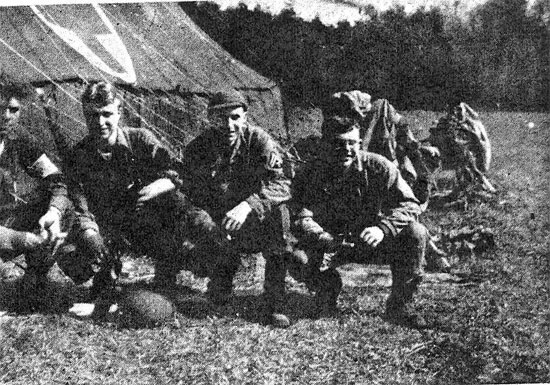
Taking a break at the bivouac spot, Bad Nauheim, Germany. Picture taken around June-July 1945.
Rhineland – 15 Sep 44 to 21 Mar 45 – by authority of Seventh United States Army, dated 28 June 1945
Central Europe – 22 Mar 45 to 12 May 45 – by authority of Seventh United States Army, dated 6 September 1945
Decorations:
The Soldier’s Medal for acts of heroism involving voluntary risk of life was awarded to 6 Officers and 7 Enlisted Men
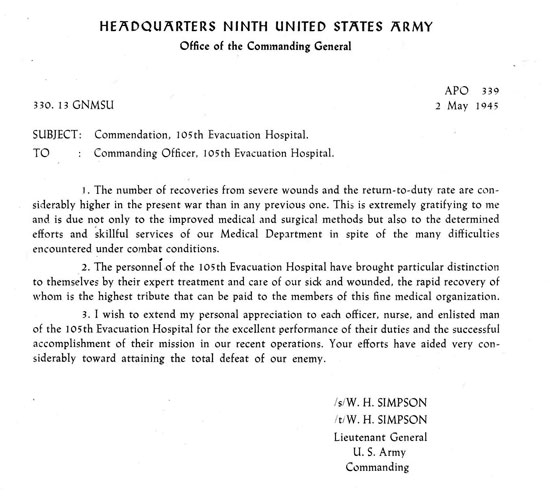
Letter of Commendation adressed to the 105th Evacuation Hospital, signed by Lt. General William H. Simpson, CG Ninth US Army, dated 2 May 1945.
The Bronze Star for meritorious service in connection with military operations was awarded to 11 Officers and 6 Enlisted Men (another 18 Officers and 28 Enlisted personnel were recommended for the Bronze Star)
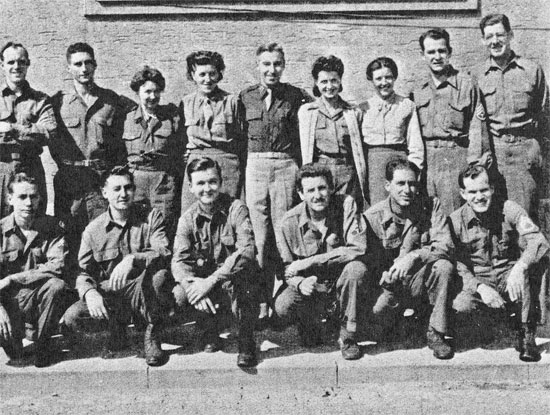
Picture showing part of the Staff of the 105th Evacuation Hospital. Taken in Germany, at the close of WW2.
105th Evacuation Hospital Locations:
Cp. Cooke, Oceano, California (Division Camp) – 10 Mar 43 > 4 Jan 44
Yuma, Arizona (Maneuvers) – 5 Jan 44 > 12 Mar 44
Ft. Jackson, Columbia, South Carolina (Infantry Training Center) – 16 Mar 44 > 10 Aug 44
Cp. Kilmer, Stelton, New Jersey (Staging Area for New York Port of Embarkation) – 11 Aug 44 > 27 Aug 44
Port of Glasgow, Scotland – 3 Sep 44 > 4 Sep 44
Bournemouth, England – 5 Sep 44 > 22 Sep 44
Camp C-5, England – 22 Sep 44 > 3 Oct 44
SS “Duke of Wellington” Troop Transport ship – 3 Oct 44 > 5 Oct 44
Omaha Beach, Normandy, France – 5 Oct 44 (5 hours)
Field E, Valognes Staging Area & Bivouac Area, Normandy, France – 6 Oct 44 > 11 Oct 44
Carentan, Normandy, France – 11 Oct 44
Maastricht, Holland – 16 Oct 44 (4 ½ hours)
Tongres, Belgium – 16 Oct 44 > 28 Oct 44
Maastricht, Holland – 28 Oct 44 > 9 Feb 45
Sittard, Holland – 9 Feb 45 > 8 Mar 45
Mulhausen, Germany – 8 Mar 45 > 1 Apr 45
Wulfen, Germany – 1 Apr 45 > 10 Apr 45
Bad Oyenhausen, Germany – 10 Apr 45 > 11 Apr 45
Hannover, Germany – 11 Apr 45 > 11 Jun 45
Bad Nauheim, Germany – 11 Jun 45 > 5 Aug 45
Bad Mergentheim, Germany – 5 Aug 45 > 2 Sep 45
Ellwangen, Germany – 2 Sep 45 >
The 105th Evac Hosp was finally inactivated at Cp. Myles Standish, Massachusetts, ZI, on 21 November 1945
A copy of the original Unit History of the 105th Evacuation Hospital, from its very activation through its participation in the final Victory in Europe was offered to our staff by Harold R. Davis, son of Capt. Albert I. Davis, MC (ASN:O-276929) who was a Surgeon with the 105th Evac Hosp in the ETO during WW2. We are truly grateful to him for having shared this valuable document with us.
